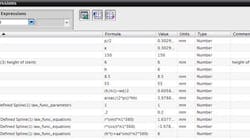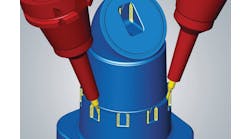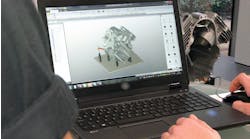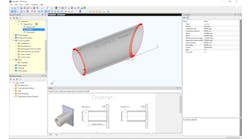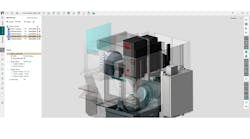Competition requires each of us to improve what we do on a continuous basis, knowing that our competitors are doing the same. If our competitors are good they spend a considerable amount of time trying to figure out how to optimize what they do, down to the last detail. When you see someone win the Indianapolis 500 you know that the driver has extraordinary skills, but the car is also a huge part of the competition. The car is the culmination of extensive research and development, and special tricks that come from years of experience. You can’t win without the great driver and the great car.
In product design, the situation is similar. In order to be competitive, you must first have the top people – the real drivers. The top people come to you with a lifetime of practical experience, plus a great education. The top people must practice their craft constantly to stay on top, as their employer must continually expose them to the latest techniques and upgrade them with education. It’s costly, but it’s worth it.
Next, top competitors must have the best tools. The nature of CAD is similar to the nature of the racecar. In the best racecars, there is a lot going on under the hood. The user interface, the steering wheel, and the pedals, are important but they are eclipsed by what the car is packing under the hood. In the top CAD tools, literally millions of man-hours have been put into programming menus and options that allow you to do anything you can possibly think of, in the shortest amount of time. The top CAD tools offer more choices of design functions than the average user will ever know, but when the average user needs that one set of esoteric commands that enables him or her to achieve more efficient performance, they’re available.
Furthermore, even the average user benefits greatly by the commands that he or she happens to use everyday. The nature of CAD is exponential. A person using a high-end CAD tool to the fullest extent is able to do in two hours what it would take the entire day to complete for someone who is using a good CAD tool.
For example, most high-end CAD systems have a command called “Curves by Law.” In the high-end CAD tools you can write a series of equations that define a geometric shape in 3-D space, then let the modeler do the work. In lesser tools you are forced to go outside the package with some exterior programming language, generate points, and then laboriously create splines through them. The added step may not seem like it wastes very much time, until you begin to iterate on the original design; then, it is a severe limitation. It is typical for engineers that have lesser tools to simply compromise on the design.
For example, using a popular high-end CAD package, a model of a stent was built. The equations were simple to input into the “Expressions Editor”, a panel of all the parameters and equations that drive all geometry within the component file. The equations capture an important characteristic of the design that is, as the component is elongated to fit into its delivery device, it contracts in its diameter. The model took minutes to build and only a mater of seconds to adjust once done.
Using some of the mid-range CAD systems, it is very difficult to make shapes like the ones shown above; once they’re made, they’re very difficult to change.
High-end software is called “high end” because it’s exceptionally capable. In companies like Pratt & Whitney, GE, Apple, and many others, it is high-end software enables designers to create things like jet engines, airframes, auto bodies and the finest handheld audio devices. They do it quickly and efficiently, and it’s one reason those companies are at the top of their markets.
The common wisdom among officials of companies that don’t design jet engines and high-end handheld devices is, “We don’t do high-end design so we don’t need a high-end CAD program.” But, one must realize that the nature of design automation is such that even simple geometry can be created much more quickly with software over which you have full control, with all the latest design automation technology. For example, most of the midrange software packages do not allow an engineer to create an extrusion in any direction. In other words, the extrusion is always perpendicular to the plane on which you sketch a contour. High-end software allows you to create a sketch or just select the edge of an existing solid, define a vector and extrude the shape as far as you want. When you change the direction of the vector, the solid updates accordingly. This gives the designer a freedom that allows great timesavings.
As a product designer aims to create the very best product possible, he or she must think about cost, manufacturing processes, safety, materials, UL listing, and a myriad of competing attributes. He shouldn’t have to conform to the limitations of their CAD software too. Midrange CAD software is limited. It brings to mind that old adage, “When all you have is a hammer, everything becomes a nail.”
For example, the maker of a handheld device creates a small enclosure for a smart phone. Because the modeler that is being used has provisions only for a blended corner that is circular/ tangent, the designer fails to produce a design that is as attractive as it might be. The designer who has the high-end CAD package has a choice between circular, curvature continuity, or conic blends. There is the opportunity to make the device more interesting and pleasing to the eye.
A reduced feature set will cost you in certain situations, but it also will be a continual source of time loss.
For many years the folks that have been creating high-end CAD systems have been forced to solve the problems of the most difficult clients, such as GM and Johnson & Johnson. These customers are a proving ground for CAD software. They are demanding, and when something needs to be improved, such as surface capability or spline creation choices, there is a lot of effort on the part of the CAD companies devoted to making it work.
The lesser CAD packages don’t have as much pressure to perform. For example, as illustrated below, a very popular mid-range software package has a problem that can cost a designer many hours. If a solid model is made, as shown on the left side of Fig. 5, and a generous fillet is placed on the hole in the flat section, the fillet should be “smart” enough to update once it’s moved into the curved section. In the mid-range packages the modeling tree shows an error as the hole is moved. The fillet becomes invalid. For a simple model like this it’s a small problem, easy to spot, but if this happened to a more complex model with an extensive modeling tree and it happened to one of the entities that was buried in the tree, it could prove very difficult to find and it may make a number of other entities fail.
In the high-end CAD packages this problem was solved years ago. Fig. 6 shows a model that was made with high-end software. As the dimension on the right is increased and the blended hole moved into a new region, the blend updates.
The quality that is put into the high-end CAD packages gives a direct benefit to those who are creating designs that could be considered “simple.” The timesavings will be real.
Mid-range CAD packages can make even simple design tasks difficult. For example, when a designer creates a sketch there should be a way to use that sketch multiple times without having to redo parts of the sketch. A user should be able to extrude a portion of a sketch, then come back later and use another part of the same sketch for another operation. In Fig. 7, a sketch is created that has more than one contour. A portion of it is extruded at first, and then the inner circles of it are extruded in different directions. The directions are defined using two different vectors. The operation is very simple. The added functionality that is afforded by the high-end software allows designers to get their jobs done much more quickly.
Another thing that is possible using high-end software is to revolve any type of curve, edge curve, or sketch around any type of line, vector, edge, coordinate system, etc. This means that whenever a designer wants to create a revolved body, it’s not necessary to go into a sketch and create extra geometry that would be necessary using mid-range CAD software. The simple solid shown in Fig. 8 depicts a shape that is very difficult, if not impossible, using mid-range CAD software.
It would be a mistake to characterize the work you do as too simple to require the high-end software, because even with simple geometry and simple products there are great opportunities for design automation. Taking advantage of these opportunities will help you to make your product-development process faster and more streamlined. You will get your product to the market sooner, with less risk, less cost, and better quality.
For example, a model of a simple cabinet is created. It has one drawer, one pull, and an overall shape that may change. Using high-end software, you may easily create a model of the outside shape, and then create components that are controlled by the main model, otherwise known as the master model. In the example shown in Fig. 9, a simple master model is created using an extruded sketch.
The various components are created by importing parametrically associative portions of the master model into each component part file. The components are shown in Fig. 10, in an exploded view. Every detailed component is linked to the master model.
When the master model dimensions are changed, every detailed component responds. All dimensions update along with all the positions in the assembly.
The master model has equations embedded in it that control things like the wall thickness of the wood, the position of the holes, and other attributes. In addition, there is a logic equation that will automatically add supports should the width of the assembly grow larger than a specific quantity.
High-end CAD software makes it possible for you to perform this simple geometry in a way that allows you to change the entire design in a few minutes. It’s easy to imagine how valuable this type of model would be, if you were really in a hurry to get your product to market. Certainly, any CAD package on the market will allow you to create the same basic model depicted above, but many mid-range CAD packages will not allow you to change it as fast, nor as thoroughly.
In most industries, there is a competitive element and a finite market. It is almost universal that getting your product to the market early will give you a great competitive edge. Getting to the market sooner will ensure that many of those customers that would have had a choice between your product and that of your competitors will choose yours. Also, when you get your product to the market sooner, you will get more experience with the product so that successive versions of the product will be better than your competitors’ designs.
Even if getting your product to the market early isn’t essential for you to compete, it’s great to have more time to iterate on your design. This will raise product quality and reduce production cost. It is difficult to place a value on having a better design than you would have had, had you used mid-range software. But, it could mean the difference between a successful product launch and losing a huge business opportunity. The cost of high-end software is generally a one-time fee that will pay dividends for years to come. High-end software is worth every penny.
Stephen M. Samuel P.E. is the president of Design Visionaries, a professional forensic engineering firm. Contact him at tel. 408-997 6323, or [email protected].
